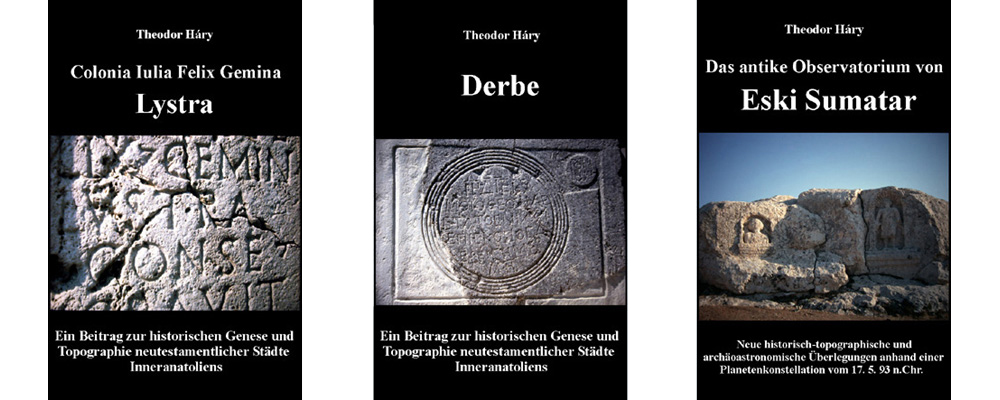Startpage │ CONTENT │ Current scientific research projects │ Deutsch │ English │ ►
Lystra ► Derbe ► Eski Sumatar ►
Lystra & Derbe – English
Colonia Julia Felix Gemina Lystra & Derbe
Contribution to the historical genesis and topography of newtestamental cities in Central Anatolia
(summary)
The primary focus of the investigation was the relatively unresearched cities visited by the Apostle Paul in Lykaonia: Lystra, Derbe, Ikonion and surrounding areas. Kolossai was also studied, but still needs to be researched in greater detail. Careful effort was made to avoid repeating work done by other experts on the topic. The research methodology follows the standard schema: ancient sources, literature, prior research, historical genesis, topography, inscriptions, coins, small finds, index and illustrations. Following the methodology of ancient history, all available historical sources of political history, Roman colonisation, province names, borders, military strategies and the construction of cities were all taken into consideration. These factors indicate a complex historical genesis to the above mentioned cities. In addition, it was discovered that the differing geographic statements of antic authors took political, but also cultural differences between landscapes and cities of Central Anatolia into account. While the colonies founded by Augustus, Ikonion and Lystra, belonged to Galatia, Ikonium was traditionally a phrygian city. The Derbe of the New Testament was located in Lykaonia Antiochiana. Initially it was a fortress of the tyrant Antipatros, but after a short period the Romans left it to the sphere of influence of Antiochos of Kommagene. These political and cultural differences also become evident in the Acts of the Apostles. According to inscriptions and small finds (including ceramics, tomb sculptures, sarcophagi, building remains and architectural fragments), Lystra experienced extensive colonisation during Roman antiquity and in the Byzantine age. In particular here are sporadic founds of chalkolithic, hettite (city of Lušna), phrygian and seldchuk potteries. In March 2004, the first exact measurings of the hill and the relics were carried out with a laser gauge, compass and GPS (global positioning system). The results reveal an acropolis, city wall and city gate, a Byzantine basilica (30 x 8 m) with apsis, baptistery, narthex and a large parvis (32 x 23m) partly constructed with the remains of an antic temple (probably Ζεὺς πρὸ πόλεως of Acts 14, 13) and Ayasma/Hagiasma-well. East of the settlement hill tombs raiders excavated simple stone sarcophagi as well as Greek and Latin inscriptions. This burial place is most probably a vast imperial necropolis (300 x 400 m). Another necropolis was found near the old cemetery north of Hatunsaray. West of the city hill there is a quarry. Newly found inscriptions (6 Latin and 4 Greek inscriptions from Hatunsaray, 2 Latin and 8 Greek from the surroundings) complement the 51 previously known inscriptions of the Colonia Lystra. Another monumental Greek tombstone which had been stored in the lapidarium of the archaeological museum in Konya has recently been published. Inscriptions give information about nomenclature, religion, social and ethnical structure of the population in Colonia Iulia Felix Gemina Lystra. Expositions on the apocryphal road of kings based on critical research of the acts of St. Paul as well as on milestone finds of Via Sebaste and traces of ancient roads in the Lystra area, broaden our knowledge of the road system of Lykaonia. In March 2004 a round fortress was discoveredon hilltop of Kerti Hüyük. The collected material of Lystra is sufficient for a scientific monograph, which might be of use for future excavations in this area. Various topographical drawings, plans and commented colour photographs are of great importance for presenting this not yet excavated antic city. The study of Derbe may also be published in a monograph with detailed topographical photographs of Kerti Hüyük, Devri Şehri, Sudurağı/Sidrova, Unu Hüyük, Kıbrıs Hüyük and Binbir Kilise. Other articles will be published in specialist journals on topics including:
1. Newly discovered inscriptions from Lystra; 2. Βασιλικὴ ὁδός – the apocryphal Kingroad of Lystra; 3. Paulus inscriptions from Asia minor; 4. New epigraphical indications of Judaism in Asia Minor; 5. The locating of Derbe; 6. The Jews of Lystra. 7. Historcal topography of Kolossai at Lykos; 8. Ikonion – historical genesis of a city of the New Testament; 9. Addressees of the letters of St. Paul to the Galatians; 10. Asia Minor and the Apokryphes of the New Testament; 11. Inscriptions and monuments of Kilistra; 12. Ilistra – a lykaonian city; 13. Early Christian monuments of Botsa near Lystra; 14. An ancient astronomic planetary constellation and the ruins of Eski Sumatar.
Eski Sumatar – English
The ancient observatory of Eski Sumatar
New considerations of the historical topography and archaeoastronomy according to the astronomic planetary constellation of 17. 5. 93 A. D
(summary)
The main objective of this project is a systematic exploration of the ancient stellar sanctuary and astronomic observatory of Eski Sumatar in northern Mesopotamia (province Şanlıurfa, southeast Turkey). The main object of this research is an ancient historical topography and archaeoastronomy. A review of prior research clearly shows that up to now on this topic only shorter epigraphical, archaeological and religious-historical essays have been written, but there is no monograph, which satisfies the demands of modern science. It was J. B. Segal, who in 1953 recognized in the ruins of Eski Sumatar the planetary sanctuaries of the old Sabians of Harran mentioned in the arabic sources. He interpreted them in connection with the theoretical study of Chwolsohn (1856). In 1995 and 1999 I led a detailed autopsy of the archaeological area of Eski Sumatar. During this occasion I became aware of the peculiarity of the architectural constructions, which have no parallels in antiquity. According to the planetary constellation from the 1stcentury A. D. (discovered with computer assistance). I hypothesized that the buildings in Eski Sumatar had been constructed for a traditional Sabian astrolatry and at the same time functioned for an as yet not understood astronomical practice. The planetary constellation happened in the early evening of 17. 5. 93 A. D. at the western horizon and corresponds exactly with the topographical realities on the site. After sunset, around 20.45 h local time all planets and the narrow sickle of the increasing new moon appeared on the ecliptic in the semicircle close together: Saturn, Jupiter, Moon, Mercury, Mars and Venus. The seven planetary sanctuaries of Eski Sumatar have the same order in the semicircle near the western horizon. Hence they form the projection of the ecliptic. In addition the planets Mercury, Mars and Venus form a kind of conjunction in Gemini and it is interesting that the sanctuaries of these planets lie exactly near the double-cave. So the double-cave could correspond to the image of Gemini. Further a conjunction took place covering the α Leo (Regulus) through Saturn and of δ Cancri through Jupiter, which additionally caused an imposing effect in the heavens. The question of how the sabian astrologue interpreted this exceptional heavenly incident arises. Perhaps they were so surprised, that they built the corresponding sanctuaries for the stellar deities. It remains unclear if they had predicted this constellation. The year 93 A. D. is the division point for the dating and also signifies terminus postquam and terminus antequam. During the survey in this area in 1999 I found a monumental relief of a lion near the Moon-sanctuary which undoubtedly symbolizes the constellation Leo. This lion-depiction and the statue of a warrior at the Mars-sanctuary could also prove that we are not only dealing with the family-tombs of nomadic sovereign as J. Drijvers in 1980 claimed. In my opinion, we are not only dealing with a cultic area and graves, but also with a precisely furnished and at the same time uniquely preserved observatory from antiquity. The discovery of this astronomical planetary constellation opens new research perspectives for the history, topography and dating of Eski Sumatar. For an astronomic interpretation of the area it will be important to determine how the buildings are oriented relative to the sky-direction, planets as well as constellations and which role the equinoctiums, solstitiums, the precession and the azimuth played at their construction. A systematic investigation and measure of the area is urgently necessary, because the remains are being destroyed and a reconstruction of the buildings will soon be impossible – an enormous loss for science. The new results of this project widens not only the essential knowledge over a specific scientific area (ancient topography, archaeoastronomy, history of the astronomy), but could also save this unique heritage of humanity before decay.

